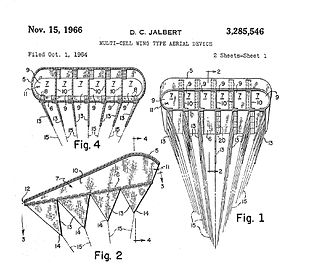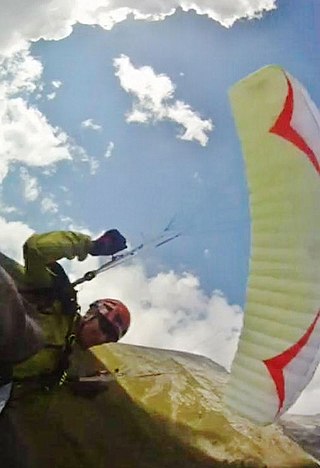
This article needs additional citations for verification .(October 2011) |
Domina Cleophas Jalbert (1904–1991) [1] invented the ram-air inflated flexible wing, often called the "Jalbert parafoil".

This article needs additional citations for verification .(October 2011) |
Domina Cleophas Jalbert (1904–1991) [1] invented the ram-air inflated flexible wing, often called the "Jalbert parafoil".
Domina Jalbert was born in 1904 in Saint-Michel-des-Saints, Quebec, Canada; his father was Onesime Jalbert (1856–1938) and his mother was Celestine Gouger (1861–1939). He was one of 17 children.
Early in his life he moved to Woonsocket, Rhode Island, where he lived and worked for many years before moving to Boca Raton, Florida, [2] in his older years.
While living in Woonsocket, Jalbert graduated from Woonsocket High School, and later worked as a track coach and administrator for Mount St. Charles Academy. [3]
Jalbert received a U.S. pilots' license in 1927. In the 1930s he was active in kiting, using large kites for advertising purposes. He was hired to help protect the coastline of the western United States during war with the design and making of barrage balloons; he worked for the United States Rubber Company in Naugatuck, Connecticut, US. [4]
Jalbert later moved to New Jersey and was married in 1933 to champion swimmer Elizabeth Becker, and they had one daughter, Dorothy Christina Jalbert (1932–2006). Elizabeth died in 1936, and Domina returned to Rhode Island.
Jalbert was married to Emma Rose Bourcier (1903–1994) on October 28, 1943, in Providence, Rhode Island. The couple moved to Belmont, Massachusetts, and were living there in 1945. They had one son, Paul Charles Jalbert (1945–1992).
Jalbert and his family relocated to Boca Raton, Florida, in 1950.
Jalbert died on June 26, 1991, in Boca Raton, Florida.
In 1942, Jalbert demonstrated the power of his custom-made kite by lifting his daughter, Dorothy Jalbert, in a "kite-swing" at Point Judith, Rhode Island.
He filed a patent in 1944 for a combination of a balloon with a stiffened flexible wing, forming what is now known as a "kytoon".
In 1956, Jalbert tested his square parachute for the first time in Boca Raton, Florida.

In 1957, Jalbert invented the ram-air airfoil and began testing and formalizing the design. [5]
In January 1963 he formally confirmed his discovery and invention of the ram-air double-surfaced fully flexible airfoil that would profoundly change kiting, parachuting, skydiving, hang gliding, paragliding, sport flying, power kiting, and more. All parafoils today owe their roots to Jalbert's invention.
In 1964, he filed a patent titled "Multi-cell Wing Type Aerial Device" This would become key to paragliding, sky diving, powered paragliding, landboarding, kite surfing and cargo-ship kite tugging. [6]
In 1971, Jalbert's dream of creating a ram-air parachute was realized. Working with Jalbert, Theodore Hulsizer, civilian prototype parachute manufacturer for the United States Air Force and NASA (1947–1973), made the first parafoil parachute that worked. While testing his prototype in the wind tunnel at Wright-Patterson Air Force Base in Dayton, Ohio, US, Theodore realized its drag was considerably stronger than any other parachute he had tested in his 25 years of experience. He believed others' attempts ripped to shreds, because of the drag. To slow the opening of the parafoil, Theodore ran the cords through rings he designed that were slid to the top while packing the parachute. As it opened, the rings had to slide down, slowing the opening. These rings later evolved to be the slider in modern ram-air parachutes. Theodore personally made the first full-size parafoil, which worked perfectly in its first drop. [7]
1984 – At age 79 Jalbert traveled to Beijing, China to demonstrate his parafoils.
Jalbert was first to teach of the robust airfoil formed by the ram-air principle. Every contemporary ram-air airfoil sport and utility wing began with Jalbert's invention. When the parafoil is used as a gliding parachute, thus opening after the payload or human has been in free-fall, the opening of the parafoil can be very fast; the fast opening and the consequential related shock has to be damped; devices invented by others are used to slow down the opening of the parafoil. One such invention is the slider. When the parafoil is used in hang gliding as a paraglider, the parafoil is kited open before the human leaves the ground; in such cases a slider is not necessary. [8]
Jalbert invented his filed-for January 10, 1963 US Patent 3131894 the Parafoil which had sectioned cells in an aerofoil shape; an open leading edge and a closed trailing edge, inflated by passage through the air – the ram-air design. [9]

Hang gliding is an air sport or recreational activity in which a pilot flies a light, non-motorised, heavier-than-air aircraft called a hang glider. Most modern hang gliders are made of an aluminium alloy or composite frame covered with synthetic sailcloth to form a wing. Typically the pilot is in a harness suspended from the airframe, and controls the aircraft by shifting body weight in opposition to a control frame.

A wing is a type of fin that produces lift while moving through air or some other fluid. Accordingly, wings have streamlined cross-sections that are subject to aerodynamic forces and act as airfoils. A wing's aerodynamic efficiency is expressed as its lift-to-drag ratio. The lift a wing generates at a given speed and angle of attack can be one to two orders of magnitude greater than the total drag on the wing. A high lift-to-drag ratio requires a significantly smaller thrust to propel the wings through the air at sufficient lift.

A parachute is a device used to slow the motion of an object through an atmosphere by creating drag or, in a ram-air parachute, aerodynamic lift. A major application is to support people, for recreation or as a safety device for aviators, who can exit from an aircraft at height and descend safely to earth.

Paragliding is the recreational and competitive adventure sport of flying paragliders: lightweight, free-flying, foot-launched glider aircraft with no rigid primary structure. The pilot sits in a harness or in a cocoon-like 'pod' suspended below a fabric wing. Wing shape is maintained by the suspension lines, the pressure of air entering vents in the front of the wing, and the aerodynamic forces of the air flowing over the outside.

The Rogallo wing is a flexible type of wing. In 1948, Francis Rogallo, a NASA engineer, and his wife Gertrude Rogallo, invented a self-inflating flexible wing they called the Parawing, also known after them as the "Rogallo Wing" and flexible wing. NASA considered Rogallo's flexible wing as an alternative recovery system for the Mercury and Gemini space capsules, and for possible use in other spacecraft landings, but the idea was dropped from Gemini in 1964 in favor of conventional parachutes.

Francis Melvin Rogallo was an American aeronautical engineer inventor born in Sanger, California, U.S. Together with his wife, he is credited with the invention of the Rogallo wing, or "flexible wing", a precursor to the modern hang glider and paraglider. His patents were ranged over mechanical utility patents and ornamental design patents for wing controls, airfoils, target kite, flexible wing, and advanced configurations for flexible wing vehicles.
Kite types, kite mooring, and kite applications result in a variety of kite control systems. Contemporary manufacturers, kite athletes, kite pilots, scientists, and engineers are expanding the possibilities.

A powered parachute, often abbreviated PPC, and also called a motorized parachute or paraplane, is a type of aircraft that consists of a parafoil with a motor and wheels.

A windsport is any type of sport which involves wind-power, often involving a non-rigid airfoil such as a sail or a power kite. The activities can be land-based, on snow, on ice or on water. Windsport activity may be regulated in some countries by aviation/maritime authorities if they are likely to interfere with other activities. Local authorities may also regulate activity in certain areas, especially on crowded beaches and parks.

A parafoil is a nonrigid (textile) airfoil with an aerodynamic cell structure which is inflated by the wind. Ram-air inflation forces the parafoil into a classic wing cross-section. Parafoils are most commonly constructed out of ripstop nylon.

A slider is a small rectangular piece of fabric with a grommet near each corner used to control the deployment of a "ram-air" parachute. Also called a "reefing device." A ram-air parachute has a tendency to open very rapidly. At high velocities, the opening shock from a rapid deployment can cause damage to the canopy or injury to the jumper. The slider was developed as a way of mitigating this. During deployment, the slider slides down from the canopy to the risers. Air resistance slows its descent. The slider holds the lines together, which slows the parachute inflation. The slider also deflects some of the rising air column away from the center of the canopy as it inflates. This also helps moderate the speed of opening. This invention solved the rapid deployment problem with ram-air designs. Sliders also reduce the chance of the lines twisting to cause a malfunction.

Hang gliding is an air sport employing a foot-launchable aircraft. Typically, a modern hang glider is constructed of an aluminium alloy or composite-framed fabric wing. The pilot is ensconced in a harness suspended from the airframe, and exercises control by shifting body weight in opposition to a control frame.

A man-lifting kite is a kite designed to lift a person from the ground. Historically, man-lifting kites have been used chiefly for reconnaissance. Interest in their development declined with the advent of powered flight at the beginning of the 20th century. Recreational man-lifting kites gradually gained popularity through the latter half of the 20th century, branching into multiple sports. In the 21st century man-lifting kites are often used in kitesurfing, where brief launches can be followed by safe water landings and parasailing, where kites are towed behind a vehicle.

The ram-air inflatable single-line kite is one of the few modern inventions in the world of kite design. Although Francis Rogallo's early kite patents had ram-air members in the claims, Domina Jalbert's parafoil ram-air wing, patented in 1944, emphatically changed the kite airscape for inflatable kites.

A glider is a fixed-wing aircraft that is supported in flight by the dynamic reaction of the air against its lifting surfaces, and whose free flight does not depend on an engine. Most gliders do not have an engine, although motor-gliders have small engines for extending their flight when necessary by sustaining the altitude with some being powerful enough to take off by self-launch.
Different types of flying kites have niche applications. In nature, some animals, such as spiders, also make use of kiting.

Kites are tethered flying objects which fly by using aerodynamic lift, requiring wind for generation of airflow over the lifting surfaces.

John Wallace Dickenson was an Australian inventor, who developed some liquid flow measuring devices and designed a successful hang glider configuration, for which he was awarded the Gold Air Medal, the highest award given by the Fédération Aéronautique Internationale, the world governing body for air sports, aeronautics and astronautics world records.

A kytoon or kite balloon is a tethered aircraft which obtains some of its lift dynamically as a heavier-than-air kite and the rest aerostatically as a lighter-than-air balloon. The word is a portmanteau of kite and balloon.

Speed-flying and speed-riding are advanced disciplines close to paragliding that use a small, high-performance non-rigid wing to quickly descend heights such as mountains. Speed flying and speed riding are very similar sports; speed flying is when the speed wing is foot-launched, while speed riding is a winter sport done on skis.
{{cite web}}: CS1 maint: archived copy as title (link) Tal Streeter in his notes towards his book about Domina Jalbert.Domina Jalbert ram air wing.